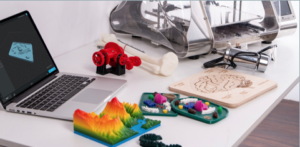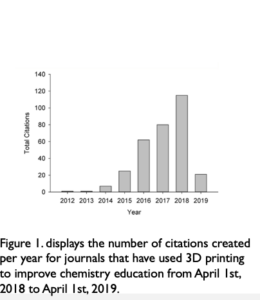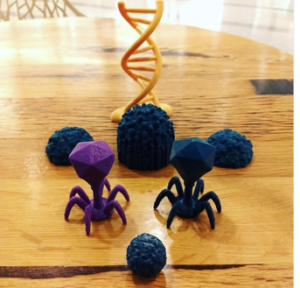
Prior Research On Tactile Teaching Tools!
Tactile Teaching Tools (TTTs) have been found to improve educational inclusion. Students with and without learning difficulties are able to collaborate with one another (2). The use of 3D printers and instructional digital software is a relatively recent approach to making TTTs. 3D printing is a technique for turning computer software into three-dimensional objects (1). One of the advantages of this technology is that it is not limited to the types of significant fields to which it may be applied. TTTs have been found to improve student’s learning outcomes in STEM fields such as engineering. “Three-dimensional (3D) printing is a promising technology in Engineering education because it may facilitate learning, contribute to the development of important skills and competencies, increase student involvement and interest, and promote their creativity,” according to Celorrio-Barragué et al. (3). Students with visual impairments and learning disabilities are typically left out of traditional learning contexts. Scientific understanding of three-dimensional processes has increased, as discussed in “STEM BUILD: An Online Community to Reduce Barriers to Implementation of Inclusive Tactile Teaching Tools”(5).
Proposal
-Purpose:
We intend to learn more about the entire benefits of TTTs and how to make STEM areas more accessible to all students.
-Objectives/Timeline:
The timeline of this study will take 1 academic year to complete including room for replication.
The objective is to gather qualitative data on the efficacy of tactile teaching tools.
-Hypothesis:
We hypothesize that the implementation of 3d printing by professors and students will increase inclusivity and understanding within STEM courses.
Methods
We intend to collaborate with NCSU’s maker space professors at DH Hill Hunt Library to create 3D creations that are relevant to General Microbiology.
Plants, microscopic organisms, and other data will be the emphasis.
The models will be finished for an instructor at NCSU who teaches General Microbiology.
These TTTs will be used in a single class for one semester.
Anticipated Problems
I expect that as a team we will experience difficulty in reaching out to different institutions in efforts to provide these resources to their students. Training will be required to faculty that does not have experience working with a 3d printer (Braier et al. 2014). Not all students are tactile learners, and will not experience much gain from TTT’s. These limitations can be fixed through the correct allocation of resources, training, and study of what demographic of students is best helped by the use of tactile teaching tools.
Budget and Timeline
In order to successfully conduct this project, we are requesting $8,000. This amount would serve a whole academic year including a summer semester. Two-fifths of the grant would go directly to our research assistants in order to have more faculty involved in the study. Student assistants will have a limit of 20 hours per week on the project. We hope to purchase a 3d printer which is approximately $2,500. Funds will help provide software design, models, and supplies for the 3d printer. The rest of the budget would be used for maintenance and equipment needed to perform the study. Any money left will be used for future replication.
ØBudget Plan:
In order to successfully complete the experiment, we are requesting $8,000.
Research Assistance
Maker space maintenance
Materials
Replication
 Importance Of Inclusive Learning
Importance Of Inclusive Learning
TTT’s have shown to improve overall understanding of biological concepts from molecular to larger-scale levels (Lathan 2021). By enabling instructors to provide a variety of teaching methods, students in STEM will be able to grasp content better. Through 3d printing, we can develop new visual and tactile learning tools that go beyond traditional textbooks and 2d digital presentations. In the past many scientific processes were led minds visual interpretation, now students will be able to have an interactive presentation of the cell cycle for example. Having more inclusive ways of introducing students to STEM courses such as Microbiology will diversify the demographics entering these fields of study. Currently, it is difficult to integrate 3d printing into all institutions across all grade levels. With the right technology and resources, instructors and students will be able to expand their knowledge of science and technology.
The 5 Most Important Advantages of 3D Printing in Education
Future designers, engineers, and artists will have all been students who were influenced by 3D printing from the standpoint of growth and development.
Creates Excitement – Students may experience their projects from the model stage to the actual construction of the model via 3D printing.
As kids acquire hands-on experience with the design process from conception to creation, this fosters both excitement and a greater grasp of it.
3D printing can help students and teachers work more effectively, regardless of what curriculum is being used.
Students can go from being passive consumers of knowledge on a screen to being productive users of that information thanks to 3D printing.
Access to previously unavailable knowledge –
It is a fun cutting-edge technology for children to master because most 3D printers are pre-assembled and plug-and-play.
Opens Up New Learning Opportunities –
For students, a low-cost 3D printer opens up a world of possibilities.
Enhances problem-solving abilities –
Students can use the 3D printer to engage in a range of learning activities.
They must understand how to run and troubleshoot various 3D printers, as well as how to troubleshoot and fix difficulties.
Many pupils may not have the opportunity to participate in this art form as part of their regular study.